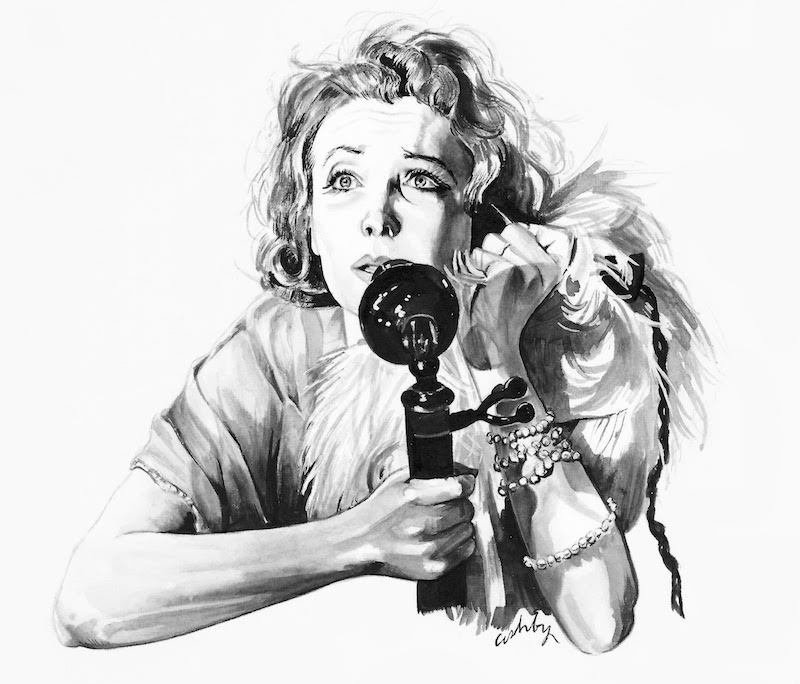We are pleased to offer an excerpt from the latest by online magazine Bright Wall/Dark Room. The theme of their February issue is Mental Health, and in addition to Paul’s piece below on “A Streetcar Named Desire,” they also have new essays on “12 Monkeys,” “Arrival,” “I Smile Back,” “Two Days One Night,” “The Devil and Daniel Johnston,” “We Need to Talk About Kevin” and “Iron Man 3.” The art below is by Brianna Ashby.
You can read previous excerpts from the magazine by clicking here. To subscribe to Bright Wall/Dark Room, or purchase a copy of their current issue, click here.
“I think she’s a spoilt rich woman a bit bored with things who is making a cracking ass of herself to get attention, and she’d be best served to pull up her bootstraps,” legendary playwright Noël Coward told his good friend and former protégé, Laurence Olivier, speaking about Olivier’s Oscar-winning second wife, Vivien Leigh. “We all have our demons, darling,” Coward added. “Adults keep them under control.”
Vivien Leigh was 36 when Coward allegedly directed this bit of advice to her husband, and was about to disappear into one of the two parts she is best remembered for today: that of Blanche DuBois in Tennessee Williams’ haunting A Streetcar Named Desire. In Hollywood terms of her day, though, Leigh might as well have been 100 years old. She had been a sensation in Gone with the Wind, sure, and perfect in that part—but that had been a decade ago already, and how much credit was there in nailing the biggest part of the biggest movie based on the biggest book ever? David O. Selznick’s publicists had pitched her to the world as a beauty, and it was accepted then that beauty—silver screen beauty, at least—lost its luster long before a woman entered her mid-30s. Most complicated of all, there was also the fact that Leigh was married to Laurence Olivier—the greatest actor and one of the greatest directors of his generation, perhaps of all time. Leigh, the press agreed, slowed Olivier down. She preoccupied him too much. He insisted on making her his leading lady and then patronized her by dimming the light of his own genius to match hers. And on top of it all, Leigh was “difficult.” She wouldn’t play the parts David Selznick chose for her; she wouldn’t obey her standard seven-year contract; she wouldn’t be good and stay in her labeled box, doing what she was told to do for as long as audiences paid to see her doing it.
History, ironically, has played its part in our forgetting of Laurence Olivier’s awesome powers—his greatest work was done on the stage, ephemeral and impossible to revisit. His wife, on the other hand, owns two of cinema’s most iconic roles. And while Scarlett O’Hara’s place in the canon is central and undisputed, it is Blanche who sears more people’s souls, Blanche who is the most unforgettable.
A Streetcar Named Desire—the film—is most often discussed as the beginning of a new movie era: The film in which Marlon Brando revolutionized acting forever, the film with which Elia Kazan brought the Method to California’s soundstages. It is too often forgotten that the movie is actually about Blanche, not Stanley, and that it is an old-school, classically trained actress by excellence, Vivien, who provides the picture with its emotional punch.
As with Scarlett, there should have been no reason for Vivien Leigh to get this part. Jessica Tandy had received a Tony Award for originating the part on Broadway, and Kazan (who had directed that production) was eager to take the entire cast—Tandy, Brando, Malden, Hunter—into the film adaptation. In the meantime, Laurence Olivier got his hands on the rights to the London premiere of the play, not for himself, but for his wife. Vivien loved Tennessee Williams’ writing and wanted the part, badly—as badly as she had wanted Scarlett 10 years earlier, when she had discovered Margaret Mitchell’s book, become obsessed, and single-handedly, it seemed, bent the film world to her will, winning the part over every other up-and-coming actress in the world.
Olivier was troubled by the similarities he saw between Williams’ tragic heroine—haunted by the loss of a lover, sexually promiscuous, publicly judged, deeply insecure and mentally unstable—and his own wife, haunted by several miscarriages, sexually promiscuous, publicly judged, increasingly insecure and mentally unstable. For two to three years prior, Leigh had been plagued by bouts of depression followed by bursts of mania; by long periods of insomnia that came hand-in-hand with a growing appetite for screaming matches and physical quarrels. Olivier, the son of a reverend and a stoical man if ever there was one, didn’t know what to make of the person his wife was changing into. He had taken her to doctors, tried to be supportive during periods of bed rest. Many of his friends—like Coward, as quoted above—felt what Vivien needed most was a shorter leash and a good smack across the chops. Some thought Vivien was overworked and subject to nervous breakdowns, and simply needed to do less—work less, smoke less, drink less.
Both Leigh and Olivier were only starting to understand what ailed her: bipolar disorder, with which she would battle for the rest of her life. In late 1949, when Olivier bought the U.K. rights to Streetcar, Vivien thought herself on the brink—either of giving in to this as-yet-unnamed disease (the term “manic depression” was only just beginning to be used, even in medical circles), or of snapping out of, as she saw it, a funk induced by a nervous breakdown a year earlier. Olivier was a believer in work. If Vivien wanted to play Blanche DuBois, she should play Blanche DuBois. Eight shows a week would leave her mind little time to get either too high or too low. And so these were his conditions: He, the theatrical giant, would direct and produce London’s production of Streetcar, but only if his wife got to star in it.
Today Streetcar is considered a classic—back in 1949-50 it was a controversial, uncomfortable novelty, especially in England. The actress playing Blanche was heckled daily by male audience members. National newspapers described the play as little more than the salacious, trashy tale of an over-the-hill hussy who, having led one man to suicide, now tricks her sister’s husband into sleeping with her—while her sister is pregnant, no less. Olivier’s position within the establishment was arguably the only thing that could make the play palatable enough to London’s critics that they would at least receive it with an open, if not friendly, mind. If Vivien Leigh was the price to pay for that entrée into the establishment’s good graces, then it was a fair one. Besides, Vivien (considered over the hill herself, and an occasional star in the gossip pages lately, due to affairs and odd, dramatic behavior) playing Blanche DuBois? Whether she was good enough an actress to live up to Jessica Tandy, the producers figured, at least the tickets would sell themselves.
In later years Vivien would remember Blanche as the part that “tipped me over into madness.” Leigh had already undergone electro-shock therapy treatments for her “mania.” Legend has it that, in the West End, she would regularly receive electric therapy in a hospital in the afternoon, before driving into the theater in London and pulling on Blanche’s wig over the faint burn marks left by the electrodes on her temples. Whether this is true or not, the extent to which Vivien was willing to put herself at risk (to “crawl over broken glass,” as Elia Kazan put it) was exceptional.
Olivier’s time at the top of his game, working so much and in such testing roles, lasted as long as it did because he built parts from the outside in: his Richard III was a fake nose and an exaggerated limp, his Hamlet a blonde dye-job and an emo pout. Even Brando, the poster child for Stanislavski’s revolutionary Method, often relied on props and crutches: Don Vito’s cat, the balled up tissues inside his cheeks. Vivien’s power, and what drained and exhausted her with every one of these great parts, was how much of herself she invested in them. “There was something heroic in the way Leigh hurled herself into her roles,” the film columnist Geoffrey Macnab wrote in 2013. She was dismissed as a fit for both Scarlett and Blanche first and foremost because the characters were Southern and she was as English as high tea. But Vivien had wanted Scarlett because she understood her with remarkable clear-eyed insight: vain, intelligent, manipulative, single-minded. And she wanted Blanche in the same way. She, too, was haunted. She, too, was fighting a daily fight to hold onto herself. And she had no illusions about Blanche’s fate: here was a character who, Vivien said, “succumbed” to being “knocked around quite a bit.” Leigh knew her own ending had yet to be written and that she, too, might end up falling short of happiness and peace. She pursued Blanche anyway. And when she got her she put so much into her—for almost a year on the stage, in those eight performances a week, and then for months shooting the film in Los Angeles—that by the end, in Vivien’s words, Blanche was “in command of me.”
It is a common criticism of Hollywood that it casts straight men to play characters of different sexual orientations, as if being gay is a performance trick; casts able-bodied actors to chase awards by acting handicapped; and white stars to play different ethnicities, as if an accent and some off-white makeup are an acceptable shortcut to believability. In its way watching Streetcar is such a powerful, disquieting experience because here is an actor—a star, no less—playing a character with mental health issues, in the midst of a nervous breakdown, while battling mental health issues and mental breakdowns herself. Vivien’s unique, exceptional genius in the role is how she manages to dangerously pour so much of her own vulnerability and fear into the performance, while never failing to shape it with purpose, focus, and craft. Her first meeting with Brando’s Stanley Kowalski is a masterclass in pacing—her affected slowness and propriety, her awkward rooting to one spot in the center of the room, making her appear brittle as glass while Brando, speaking louder and acting casually and freely, moves confidently around her and around the room. She is like a bird who has wandered onto a predator’s turf and, seen by him, is aroused by him even as she tries to win him over. Her eyes drift down and away, her hands creep up and then tensely clutch each other as she tries to regroup. Contrast that with the final, famous, heartrending “kindness of strangers” scene—in which Blanche, over the edge now, is still, her eyes wide and focused on the doctors who come to take her away. Leigh does not try to over-sell us a performance of someone experiencing some kind of out of body trance—she abandons herself to that state of being, and her body expresses it. She looks like a child, the tear appearing on her cheek so unforced one only spots it once it is already there and drying, a glistening smudge under her eye.
As Blanche spirals out of control over the course of the movie, Vivien favors confusion and quiet horror over histrionics. There is no one in that movie better at maximizing a close-up or a long shot. She plays Blanche as she is, Blanche as she remembers herself being, Blanche as she cannot help herself being.
So much of the challenge of screen acting is in the transitions: transitions between emotions, between listening and responding, between a state of ignorance and a state of awareness. Pulling these off seamlessly and naturally—even as an actor delivers the scene in bite size increments for different camera angles, never forgetting to hit her mark—is what makes a performance feel true. Leigh’s performance in Streetcar doesn’t only feel true because she knows what Blanche is going through, but because of the way she handles those transitions—and there are so many of them, overlapping one another, combining and challenging one another.
Blanche is unstable, attempting to manipulate Stanley and Stella while being manipulated by Stanley herself, in many ways misrepresenting herself to herself. She is emotionally and physically manhandled from beginning to end. She talks a lot, and usually to cover up something unrelated to, or in conflict with, what she is saying. Leigh stitches this all together into a performance that is continuous and real, as grounded and as un-theatrical as the jobs done by any of her Method-trained New York co-stars. She does it all with self-knowledge and self-confidence, knowing the world would likely not separate the performance from the performer—that, even if she wowed critics and audiences alike, it would be put down to some kind of shamelessness on her part in playing a (shocking, depraved) role so close to her own flaws and indiscretions.
The stigma of mental illness, in the case of famous figures like Vivien Leigh (or Carrie Fisher, or Stephen Fry, or Sinead O’Connor), comes intertwined with a sort of myth-making: Being mentally ill makes you weird, different, lesser, somehow—but simultaneously it is also somehow the source of all your “powers,” the fount of your creativity, the drive of your uniqueness. In the eyes of many, Vivien Leigh being so similar to Blanche Dubois is her performance—her willingness to dive deep into her own mental health issues somehow erasing any ability to apply a craft, or excel at a profession. Leigh’s performance of Blanche in fact echoes to this day as a testament to her courage and her artistry alike. This past September, the sale of hundreds of Vivien Leigh’s private items—including items collected when she played Blanche—netted over $3 million through auctioneers Sotheby’s. The collection drew thousands of people, from all around the world, whose experiences of mental illness (be it theirs, a friend’s, or a loved one’s) was shaped and assisted by Vivien Leigh’s handling of her own. Leigh’s legacy—both the fascination with her private life and the unusual potency of her film work—is built on her honesty as an artist, Blanche being the most salient case in point: Here was an actress whose industry wanted to confine her to easy stereotypes, playing a character that the guardians of good taste and decency similarly sketched out in simplistic, sensationalistic lines. Vivien Leigh challenged all expectations, as she had done over and over in her career, and portrays Blanche DuBois with the skill of a genuinely humanist artist: tolerant, full of compassion and lucidity, devoid of illusions but also of judgment. It changed filmic portrayal of mental illness forever (Google any list of films that portray mental health issues “right,” none of them include a film made before 1951).
A Streetcar Named Desire won Vivien Leigh her second Academy Award—after the one earned for Gone with the Wind—effectively bookending her screen career with Oscars. It changed the world’s opinion of her—lastingly so. Pauline Kael, writing in The New Yorker two decades later, thought Blanche one “of the greatest performances ever put on film…one of those rare performances that can truly be said to evoke pity and terror.”
Blanche DuBois is one of the greatest performances in cinema history, delivered by an actress many considered to be done on the screen—an actress who knew the world was waiting to cast Blanche, and herself, with the usual stigmas associated with women and mental illness: spoilt, difficult, self-indulgent, whining. We all have our demons, darling. Adults keep them under control.











